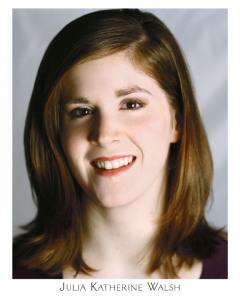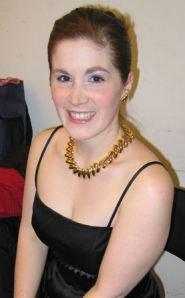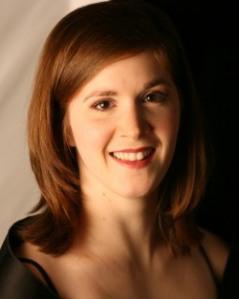 Reading, Pennsylvania native Julia Katherine Walsh came home Memorial Day weekend to sing for a friendly crowd gathered at Trinity Lutheran Church in downtown Reading, the perfect venue for an evening of intimate music performance.
Reading, Pennsylvania native Julia Katherine Walsh came home Memorial Day weekend to sing for a friendly crowd gathered at Trinity Lutheran Church in downtown Reading, the perfect venue for an evening of intimate music performance.
Currently, she resides in New York and holds a master’s in music from Hunter College. However, since she was raised in Berks County and is an alumna of the Berks Classical Children’s Choir, in every respect Miss Walsh is the quintessential hometown girl-made-good. As such, her homecoming was celebrated robustly, on billboards around the county, on local television and radio shows in advance of the concert, and in the many personalized ads appearing in the event program, one of which said, “Thank you, Julia Katherine Walsh, for sharing your angelic voice with Berks County.” (From her friends at Performance Toyota–and if she doesn’t drive a Toyota, I think she should think about it.)
Indeed, her recital called “A Celebration of Song,” was something to celebrate. Well planned, well performed, very warmly received.
As far as classical music goes, I prefer a program that stretches me as an audience member and doesn’t indulge all my musical whims. Sure, a recital can contain a potboiler or two, but how much richer will the concert experience be if it introduces you to a new piece of music or several? Miss Walsh’s selections included some accessible pieces such as “America the Beautiful”–it was Memorial Day weekend after all–and “Caro nome” from Rigoletto. However, it also included four lesser known Baroque pieces by Handel, four Lieder by Richard Strauss, and a piece totally unfamiliar to me as a musical work, James Agee’s ”Knoxville: Summer of 1915” set to music by Samuel Barber, which turned out to be my favorite selection in the concert because of Miss Walsh’s performance of it.
Her particular gifts for interpreting Mozart, German Lieder, and operas centered on American Realism were well showcased in this program. She sings with intelligence and sensitivity. She has a strong, agile voice with a crystal clear ring to it, pleasing like a shiny silver bell–a tone I happen to be partial to. Her voice seemed to suit her. She is petite and effervescent and somehow, a dark, dramatic timbre would not have been nearly as fitting a vocal quality based on her stature and personality.
In addition, she showcased her voice to its full potential, including skill with coloratura, and most impressively, a knack for selecting pieces well-suited to her particular blend of singing and acting talents.

Backstage at New York Lyric Opera's Artist in Residence concert
Her aria from The Tales of Hoffmann, “Les Oiseaux dans le charmille,” was utterly charming, capturing the requisite comic nuances such as the doll being thoroughly entertained and pleased by her own exploits as well as running out of oomph and needing to be wound up again to go on. I was likewise impressed with her facility with the “Queen of the Night Aria” from The Magic Flute, not listed in the program, performed almost as an encore.
Skillfully accompanied on piano by Rebecca Grass Butler, a professor of music at Albright College, the combined talents of Miss Walsh and Miss Butler, in addition to the pleasing venue on a comfortable just-summer evening, made ”A Celebration In Song” a delightful event, which earned her a standing ovation. Her star is rising quickly, and the next time she comes to town, a recital by Julia Katherine Walsh may not be nearly as accessible or affordable.
I caught up with Miss Walsh via email after the concert, and she graciously agreed to answer some questions about her program.
How did you select the program (who selected the program)? I selected the program after considering these few parameters:
- What do I know that I can sing well, but still feel comfortable enough to perform in an intimate setting after a shortened rehearsal period;
- I wanted to sing some familiar pieces to the audience (hence why the Doll Song, “Queen of the Night,” and “Caro nome” made the list); and
- I wanted to have a good mix of different styles in the songs that weren’t familiar (which is why the Handel pieces were mostly Italian and simple harmonically, the Strauss were super-late in his compositional period and in German, and the Knoxville was a very authentic piece of musical ‘Americana’).
Did you translate what you were singing? Yes. It is absolutely imperative to translate what you sing as a singer, but I also want to say that the translations on the “Aria and Art Song Database” are sometimes 99.9% the same as my own translations, so I use those too, if I don’t have my own already typed up.
How long did you rehearse for this? Three months. I got back to the United States from my audition time in Germany on March 3rd, and practice for this began on March 5th.
Did you have a favorite piece that you performed? My favorite piece of the evening (talking about the whole piece, not just a section of it) was the third song of the Strauss set, “Saeusle, liebe Myrte.” But, my favorite section of a piece from that evening was the line in Samuel Barber’s “Knoxville: Summer of 1915″ where the text is “By some chance, here they are, all on this Earth. And who shall ever tell the sorrow of being on this Earth? Lying on quilts, on the grass in a summer evening, among the sounds of the night.” I think that that is the best part of that piece, without a doubt.
I really liked the Barber piece on you? Tell me more about how long you’ve been singing that piece and why it made the program. I actually began working on the Barber piece in 2007 for about 6 months, but at that point it was a bit too big of a sing for me (in terms of stamina vocally-speaking) so then I put it aside and didn’t work on it again until just at the beginning of March of this year. It seems to have become much more of a fit for me; the diction and vocalism are much easier to get across to the audience clearly (which before were a problem because of the sometimes difficult words in awkward places in the vocal tessitura), and the message of the text (so superbly written by James Agee from his book A Death in the Family) means more to me now that I have lived longer in the world since I last sang this piece. It made the program simply because I think it’s a wonderful piece which is written in English and not nearly performed as often as it should be. Plus, it was a big challenge to the audience too, I think, because of its length and form.

a photo from her website
I am sure not many people that evening had heard something that is almost a mini-opera unto itself like that, and I wanted to stretch the listeners’ ears so that they will be open to hearing it again (hopefully with orchestra in the future!).
One thing I’d like to add is that I really appreciated everyone coming out on a Friday night before Memorial Day Weekend to listen to classical singing. That was a wonderfully heartening show of support by the community not only of my singing, but also of classical music in general, and I really can’t thank everyone enough for attending such a meaningful and transformative art form.
* * *
You can follow Julia on Twitter at @operadventuress and friend her on her Facebook page at Julia Katherine Walsh. You can find out more about her musical background here. For audio clips and other goodies, you can visit her website at http://juliakatherinewalsh.weebly.com/. Visit her blog “Opera Adventuress” at http://operaadventuress.blogspot.com/, especially if you want to read about how she chose her gowns for this recital. (You chose well, Miss Walsh!)

